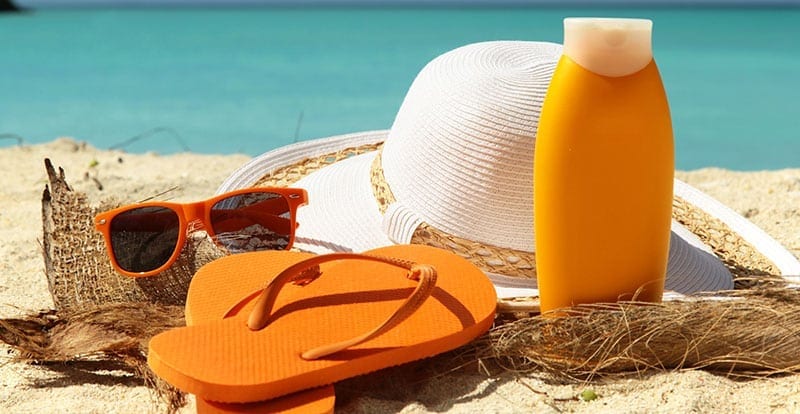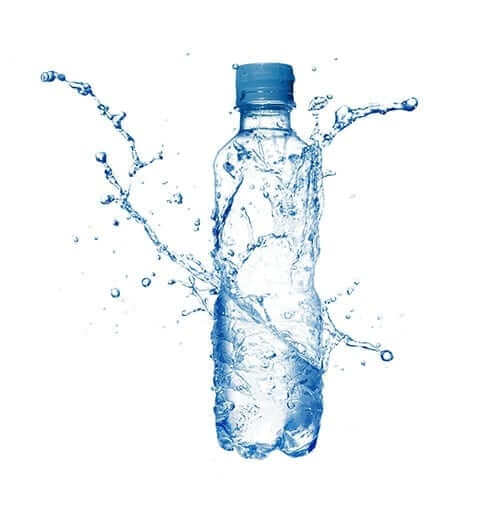Global warming or not, each summertime gets progressively hotter and August is known to be one of the hottest months of the year! According to the Academy of Dermatology, “One in five Americans will develop skin cancer in their lifetime.” The summer sun can cause major havoc to our skin. The ADA also recommends “selecting a sunscreen of at least 30 SPF (blocks 97% of the rays), with broad spectrum coverage and that is water resistant.” No sun screen, including 100 SPF, blocks 100% of the sun’s rays. The sun rays that reach the earth are both UVA and UVB rays and both are cancer causing. The SPF in a sunscreen that is made in the United States indicates, “a measure of protection against UVB rays but not UVA rays.” Unless you see “broad spectrum” on the US label, you are not protected from those UVA rays. Remember, sun burn can raise blood sugars just like infections. Another important aspect of summer care with diabetes is staying properly hydrated. High blood sugars can cause dehydration and dehydration can cause high blood sugars. You need to be protected from both. Let’s look at ways to prevent these situations this summer to keep you feeling and staying well:
Part A – What Are The Concerns of Summertime Intense Sun and Sunburn?
What is The Difference Between UVA and UVB Rays?
UVA rays can pass through glass and cause browning, aging spots, wrinkles and cancer. UVB rays can’t pass through glass but can cause sunburn and cancer.
What Are The 2 Types of Sunscreen Products?
Physical blockers and chemical blockers are the 2 types of sunscreen. Physical blockers “deflect and scatter the rays before they penetrate the skin” and the chemical blockers “absorb UV rays and convert the suns’ radiation into heat energy.” The physical blockers contain either zinc oxide or titanium oxide. In past years, the physical blockers were heavy, greasy, thick, white and difficult to absorb into the skin. To make zinc oxide more sellable, companies used to put colors like hot pink, lime green and acid yellow into the formulation to make it more attractive, fun and wearable. The more recent formulations are creamy and absorb easily and directly into the skin and are now considered “cosmetically acceptable.” Today’s zinc oxide preparations do a great job of protecting you from both UVA and UVB rays. Chemical blockers are not as straight forward as physical blockers and have some controversy surrounding them. One of the more common chemical blockers in US sunscreen formulations is Oxybenzone. Oxybenzone may cause allergic reactions in many people. The second concern is oxybenzone has “an estrogen effect activity like an estrogen cream” which was noted in animal studies. Estrogen is a female hormone which may cause serious side effects. Other chemical formulations include salicylates, cinnamates and avobenzone which do not cover UVA and UVB rays as well as physical blockers.
Why Do The European Nations Offer Different Products?

Who Should Use It, How Is It Available and How Much Should I Use?
Everyone older than 6 months should use sunscreen daily whether you have fair or dark skin. Sunscreen should be used year-round and even on cloudy days since “80% of the rays can still be absorbed.” Light skinned, light eyed and light-haired people are more prone to sunburn and skin problems, but everyone, including African Americans are at risk. Darker skin tones do contain more melanin but it only protects you to a certain extent. People with impaired immune systems such as diabetes, thyroid disease, HIV/AIDS, Lupus, MS, etc. are more at risk for skin cancer but anyone is a potential victim for skin cancer. Sunscreen is now available in lotions, ointments, gels, creams, sprays and wax sticks. The standard amount recommended by the ADA should be a “shot glass full” per full-body application. In addition to all the regular spots like face, arms, legs, trunk, it should be placed on the ears, hands, the tops of the feet and toes, hairline and the entire head, if bald. Lips are quite prone to sunburn and a lip balm with SPF of 30 or more should be used. Even if sunscreen is water resistant, FDA will no longer allow labels as water-proof, it should be reapplied every 2 hours or more frequently if spending time in the water. It is best to apply 15-30 minutes on dry skin, prior to sun exposure.
What About Sunless Tanning Products and Tanning Booths?
Sunless tanning products give the “look of sun” without the exposure to the UVA and UVB rays. They are available in lotions, creams, towelettes and sprays. Even if they do contain a small amount of sunscreen, they do not protect against sunburn. If you do decide to use this temporary product, do not put near your mucus membranes including the mouth, nose or eyes. Tanning beds can cause sunburn, cataracts and skin cancer since they give off UVA and UVB rays. “A base tan does not protect you from future damage” and tanning beds may cause serious damage.
What Else Can I Do to Protect Myself From the Summer Sun?
Try to avoid the sun from 10AM-3PM since that’s when the rays are the strongest. If you must be outside, wear clothing that is light colored, wicks away perspiration and contains SPF50 for protection. Always wear sunglasses that protect from UVA and UVB rays. Try to make sure the sides of the glasses are high and wide to protect your peripheral vision. Sunglasses can reduce your risk of cataracts. Footwear should be protective even in the summer heat and avoid flip flops.
What If I Do Get Sunburned?
Take a cool bath and gently pat dry excess moisture from your skin. Apply a simple white moisturizer or Aloe gel/lotion while the skin is still moist. Aloe, a natural plant, “has been shown to help heal minor skin wounds. It also contains vitamins, minerals and anti- bacterials.” Aloe gel can be frozen into ice cubes and applied to the sunburn for cooling relief or simply stored in the freezer/refrigerator. If you suffer from swelling, consider taking aspirin, Tylenol or ibuprofen. OTC cortisone cream may also be effective for itching and swelling. Drink extra water since sunburn may cause dehydration. If you develop a fever, blisters, open wounds or tearing of the skin, have a headache or the chills, consult your physician immediately.
Part B – What About Summer Hydration and Dehydration Especially When You Have Diabetes?

What Can You Typically Do Daily To Help Prevent Dehydration?
1. Always Carry A Water Container
We used to rely on disposable, plastic water bottles but today we have so many more exciting options. There are stainless steel containers that keep water cold for hours. There are individual glass bottles that have infuser inserts which allow you to add lemons, strawberry, orange, lime or cucumber slices for more flavor and no calories. Use ice chips to suck on throughout the day to keep you hydrated and your mouth moist. You can add herbs like lavender or basil to the cubes for taste. Stay away from carbonated water since it fills you up quickly, making you drink less and may keep you dehydrated. Chewing sugar-free gum may also keep your mouth moist.
2. Ice Cold Or Room Temperature Water.
Drinking cold water will lower body temperature faster than warm water since it “gets absorbed more quickly.” Some people just prefer room temperature water since “it does not shock the system.” There are varying medical opinions about what temperature water should be but the most important point is to drink water!
3. Skin Pinch
If you can pinch your arm skin and it goes back instantly then you are hydrated. If you pinch up your skin and it takes a while to recover then you need more fluid.
4. Eat Vegetables and Fruits That Are Water Packed Daily.
Try to avoid boxed, bagged and processed foods especially in the summer heat since they contain little or no water and high amounts of sodium. Foods to eat are cucumbers, green peppers, iceberg lettuce, celery, spinach, grapes, watermelon, cantaloupe, strawberries, raspberries and pineapples. These fruits and vegetables contain potassium as well which is an important electrolyte.
5. Coffee and Tea
Coffee and tea, both hot or iced, are no longer “off the list” for the caffeine content. Caffeine used to be considered a diuretic and research now disputes this. Coffee and tea are now counted as fluid to help prevent dehydration. Do not forget about herbal tea which is delicious, calorie free and refreshing.
6. Forget Alcohol
During the summer, a few iced cold beers, wine cocktails, gin and tonics or Margaritas may sound great but are dehydrating. Alcohol decreases the production of ADH, anti-diuretic hormone, which increases urination and leads to more dehydration.
7. Sport Drinks.
Unless you are exercising intensely, for over 60 minutes in high heat, you do not need to drink sport drinks. Most sport drinks are loaded with sugar and calories along with too much sodium. If you feel you need the electrolytes, find a reduced calorie product or consider making your own.
8. Any Calorie-Free Flavored Water Will Do.
Always check labels since there may be added sugar in some flavored products.
9. Cold Summer Soups.

10. Medication and Supplies.
Remember when the heat bothers you it also influences your medications, insulin and supplies. Do not store in the car, luggage or at the beach unless placed in a cooler. Do not let products directly touch ice packs. Meters and strips should be kept out of the heat as well.
11. Do Not Forget to Exercise.
Do not use the heat and humidity excuse to avoid exercise during the summer months. Either visit a community center, a fitness center or walk in the mall. Go to the swimming pool early in the morning or ride an indoor stationary bicycle. Attend an indoor yoga/Pilates class or aerobic training session. Take a dance class or a ballet bar class. Move!!
Summertime will be gone in a flash. Enjoy the lazy days of summer but use common sense to stay sun burn free and hydrated to keep your diabetes numbers under control. Enjoy your summer!
Have a question or comment? Then post below, no registration required. I would love to hear from you!
NOTE: Consult your Doctor first to make sure my recommendations fit your special health needs.







Leave A Comment